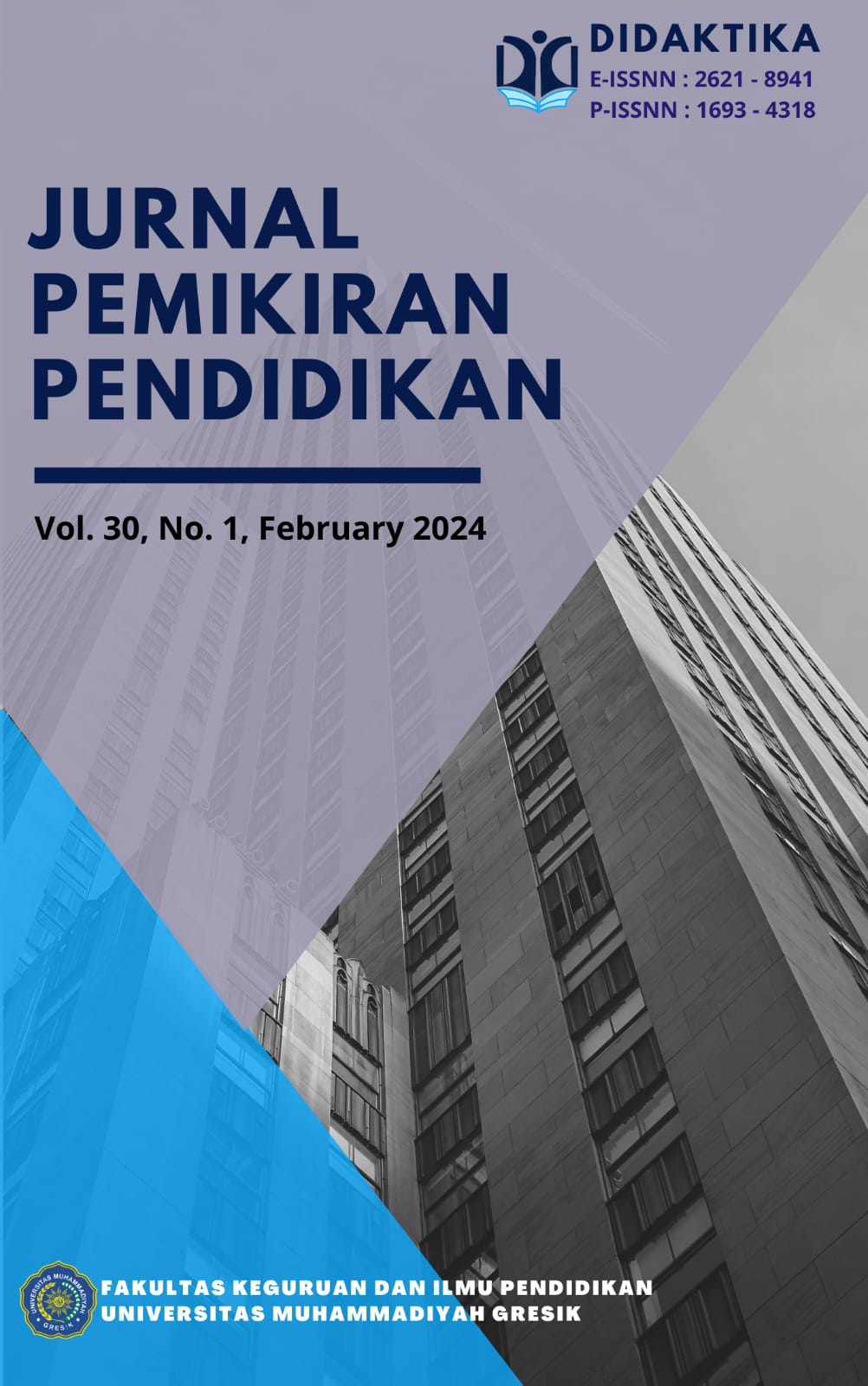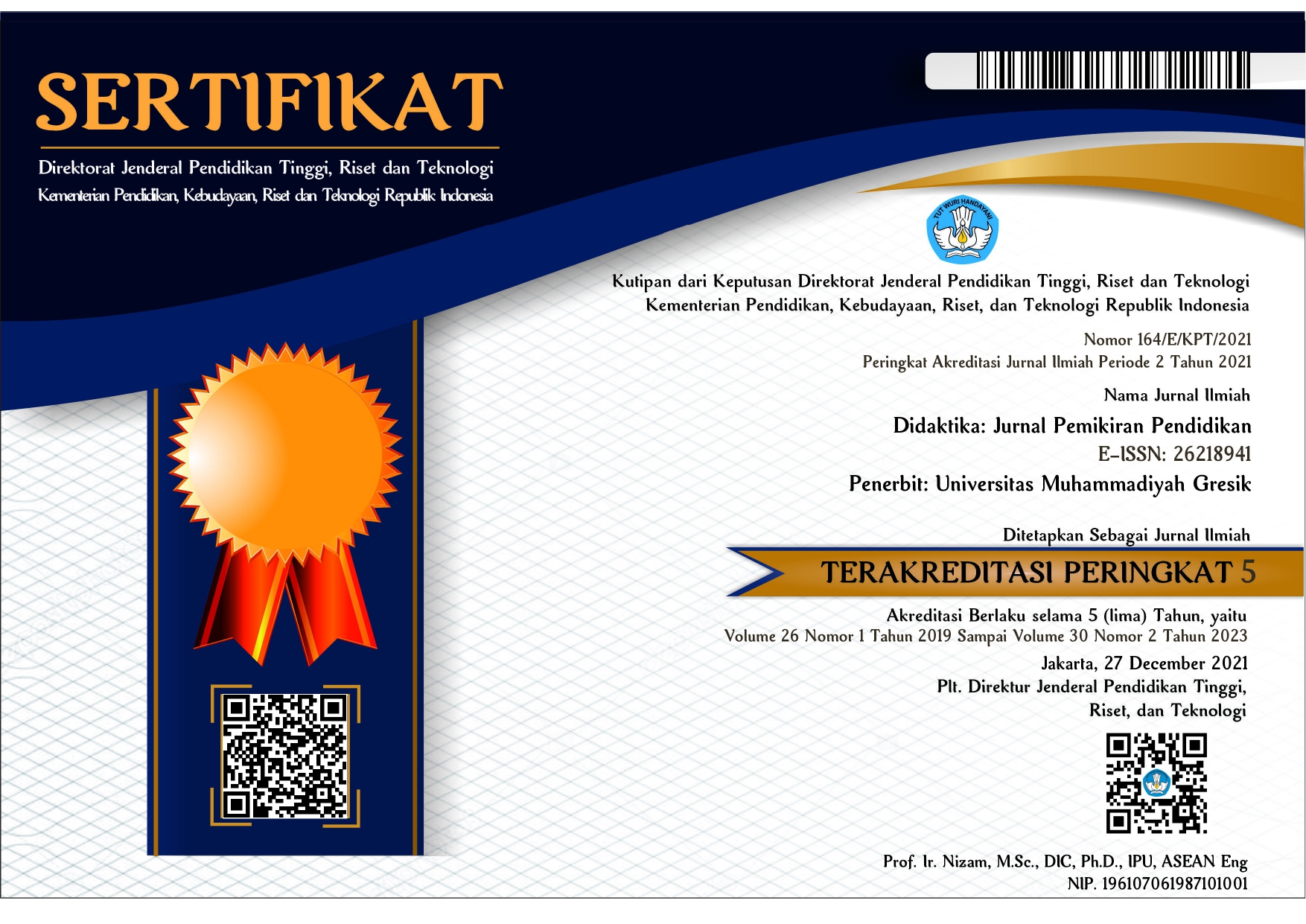Analisis Kesesuaian Proses Pembelajaran Fisika dengan RPP Pada Materi Fluida Statis Di MAS Laboratorium Melalui Pengamatan Video Pembelajaran Menggunakan TBLA
DOI:
https://doi.org/10.30587/didaktika.v30i1.6923Keywords:
Physics education; TBLA; Video pembelajaranAbstract
Penelitian ini dilakuakn untuk mengetahui kesesuaian proses pembelajaran fisika dengan RPP yang digunakan oleh guru model pada materi Fluida Statis. Penelitian ini dilakukan dengan mengamati dua buah video rekaman proses pembelajaran yang dilakuakan di MAS Laboratorium. Video rekaman tersebut didapatkan dari Prodi PPG Universitas Jambi. Penelitian ini merupakan penelitian studi kasus dengan jenis penelitian kualitatif. Dalam penelitian ini digunakan analisis TBLA untuk mengetahui kesesuain proses pembelajaran fisika dengan RPP berdasarkan transkrip pembelajaran. Pada penelitian ini didapatkan hasil bahwa proses pembelajaran fisika pada materi Fluida Statis di MAS Laboratorium Kota Jambi yang dilakukan dengan RPP yang digunakan oleh guru model dapat terlihat bahwa pembelajaran dari pertemuan 1 dan pertemuan 2 telah sesuai dikarenakan proses pembelajaran telah memenuhi sintaks model PBL yang digunakan dalam RPP
References
Andari, R. D., Basri, H., Tafrilyanto, C. F., & Lanya, H. (2022). Analisis Model Pembelajaran Dan Identifikasi 2C Siswa Smp Dalam Pembelajaran Matematika Melalui Tbla. Pedagogy: Jurnal Pendidikan Matematika, 7(2), 146–160. https://doi.org/10.30605/pedagogy.v7i2.2099
Astuti, T. P. (2019). Model Problem Based Learning dengan Mind Mapping dalam Pembelajaran IPA Abad 21. Proceeding of Biology Education, 3(1), 64–73. https://doi.org/10.21009/pbe.3-1.9
Elvera, & Astarina, Y. (2021). Metodologi Penelitian. Penerbit Andi (Anggota IKAPI).
Fitriana, M., Hasanuddin, Artika, W., Samingan, & Safrida. (2022). Analysis of Biological Learning Process Through Lesson Study by Using Transcript Based Lesson Analysis on Nervous System Material Pendahuluan. Jurnal Pendidikan Sains Indonesia, 10(2), 440–450. https://doi.org/10.24815/jpsi.v10i2.24433
Gaudin, C., & Chalies, S. (2015). Video viewing in teacher education and professional development: A literature review. Educational Research Review, 16, 41–67. https://doi.org/10.1016/j.edurev.2015.06.001
Inah, E. N. (2015). Peran Komunikasi dalam Interaksi Guru dan Siswa. Jurnal Al-Ta’dib, 8(2).
Muliarta, I. K. (2018). Menerjemahkan Perubahan dari TCL (Teacher Center Learning) ke SCL (Student Centered Learning). Cetta: Jurnal Ilmu Pendidikan, 1(2).
Murzanita, M., Susanti, N., & Lestari, N. (2021). Analisis Pembelajaran IPA Pada Materi Cahaya Dengan Lesson Study Berbasis TBLA (Transcript Based Lesson Analysis) Kelas VIII SMP Islam Al-Falah Kota Jambi. Jurnal Pembelajaran Fisika, 10(2), 54–61.
Musdar, M. (2018). Pemetaan konsep fisika siswa kelas XI pada kurikulum 2013. Jurnal Pendidikan Fisika Dan Keilmuwan (JPFK), 4(1), 36–41. https://doi.org/10.2572/jpfk.v4i1.1909
Putri, R. R., & Susanti, N. (2021). Implementasi Lesson Study Sebagai Upaya Meningkatkan Partisipasi Aktif Siswa Dalam Pembelajaran Virtual. Jurnal Pembelajaran Fisika, 10(2).
Samudra, G. B., Suastra, I. W., & Suma, K. (2014). Permasalahan-Permasalahan yang Dihadapi Siswa SMA di Kota Singaraja dalam Mempelajari Fisika. E-Journal Program Pascasarjana Universitas Pendidikan Ganesha, 4.
Saregar, A., Diani, R., & Kholid, R. (2017). Efektivitas Penerapan Model Pembelajaran ATI ( Aptitude Treatment Interaction ) Dan Model Pembelajaran TAI ( Team Assisted Individualy ) : Dampak Terhadap Hasil Belajar Fisika Siswa. Jurnal Pendidikan Fisika Dan Keilmuan (JPFK), 3(1).
Skukauskaite, A., & Girdzijauskiene, R. (2021). Video analysis of contextual layers in teaching-learning interactions. Learning, Culture and Social Interaction, 29(February). https://doi.org/10.1016/j.lcsi.2021.100499
Sondole, V., Taunaumang, H., & Komansilan, A. (2023). Penerapan Model Problem Based Learning (PBL) pada Materi Elastisitas Bahan Untuk Meningkatkan Proses dan Hasil Belajar Siswa di Kelas XI IPA. Jurnal Pendidikan Fisika, 4(1), 31–36.
Sumiati, E., Septian, D., & Faizah, F. (2018). Pengembangan modul fisika berbasis Scientific Approach untuk meningkatkan Keterampilan Proses Sains siswa. Jurnal Pendidikan Dan Keilmuan (JPFK), 4(2), 75–88. https://doi.org/10.2572/jpfk.v4i2.2535
Supriatna, A. (2018). Kegiatan Lesson Study sebagai Upaya Guru untuk Menemukan Pembelajaran yang Memenuhi Keperluan Anak Hidup pada Zamannya (Era Revolusi Industri 4.0). Seminar Nasional Edusainstek.
Susetyarini, E., Wahyuni, S., & Latifa, R. (2021). Lesson Study Learning Community melalui Model Transcript Based Learning (TBLA) dalam Pembelajaran IPA. JINoP (Jurnal Inovasi Pembelajaran), 7(2).
Tampubolon, R., Gulo, Y., & Nababan, R. (2022). Pengaruh Reformasi Kurikulum Pendidikan Indonesia Tehadap Kualitas Pembelajaran. Jurnal Darma Agung, 30(2), 389. https://doi.org/10.46930/ojsuda.v30i2.1748
Downloads
Published
How to Cite
Issue
Section
License
License and Copyright Agreement
In submitting the manuscript to the journal, the authors certify that:
- They are authorized by their co-authors to enter into these arrangements.
- The work described has not been formally published before, except in the form of an abstract or as part of a published lecture, review, thesis, or overlay journal.
- That it is not under consideration for publication elsewhere,
- That its publication has been approved by all the author(s) and by the responsible authorities – tacitly or explicitly – of the institutes where the work has been carried out.
- They secure the right to reproduce any material that has already been published or copyrighted elsewhere.
- They agree to the following license and copyright agreement.
Copyright
Authors who publish with DIDAKTIKA: Jurnal Pemikiran Pendidikan agree to the following terms:
- Authors retain copyright and grant the journal right of first publication with the work simultaneously licensed under a Creative Commons Attribution License (CC BY-SA 4.0) that allows others to share the work with an acknowledgment of the work's authorship and initial publication in this journal.
- Authors are able to enter into separate, additional contractual arrangements for the non-exclusive distribution of the journal's published version of the work (e.g., post it to an institutional repository or publish it in a book), with an acknowledgment of its initial publication in this journal.
- Authors are permitted and encouraged to post their work online (e.g., in institutional repositories or on their website) prior to and during the submission process, as it can lead to productive exchanges, as well as earlier and greater citation of published work.
Licensing for Data Publication
Open Data and Software Publishing and Sharing
The journal strives to maximize the replicability of the research published in it. Authors are thus required to share all data, code or protocols underlying the research reported in their articles. Exceptions are permitted but have to be justified in a written public statement accompanying the article.
Datasets and software should be deposited and permanently archived inappropriate, trusted, general, or domain-specific repositories (please consult http://service.re3data.org and/or software repositories such as GitHub, GitLab, Bioinformatics.org, or equivalent). The associated persistent identifiers (e.g. DOI, or others) of the dataset(s) must be included in the data or software resources section of the article. Reference(s) to datasets and software should also be included in the reference list of the article with DOIs (where available). Where no domain-specific data repository exists, authors should deposit their datasets in a general repository such as ZENODO, Dryad, Dataverse, or others.
Small data may also be published as data files or packages supplementary to a research article, however, the authors should prefer in all cases a deposition in data repositories.











